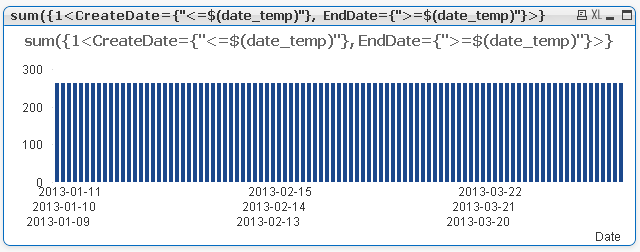Unlock a world of possibilities! Login now and discover the exclusive benefits awaiting you.
- Qlik Community
- :
- All Forums
- :
- QlikView App Dev
- :
- Re: Use date as reference in set analysis
- Subscribe to RSS Feed
- Mark Topic as New
- Mark Topic as Read
- Float this Topic for Current User
- Bookmark
- Subscribe
- Mute
- Printer Friendly Page
- Mark as New
- Bookmark
- Subscribe
- Mute
- Subscribe to RSS Feed
- Permalink
- Report Inappropriate Content
Use date as reference in set analysis
Hi!
I'm trying to compare a contracts start and end date to a date to see how many contracts that are opened at a certain date. I've managed to to this using 'today()' using the following formula:
sum({END_DATE={">=$(=today())"}, START_DATE={"<=$(=today())"}, Period=, Year=, Quarter=, Month= >} Price)
So this one works for today(), but how should I do to replace today() with all dates in a certain span to see how it changes over time? I've tried to use this code:
sum({END_DATE={">=$(Date)"}, START_DATE={"<=$(Date)"}, Period=, Year=, Quarter=, Month= >} Price)
But this date is connected to another Date in the Link Table which creates a problem.
So basically what I want to do is generate all dates for a given span so I can use this date as I use today() i the first formula.
- « Previous Replies
-
- 1
- 2
- Next Replies »
- Mark as New
- Bookmark
- Subscribe
- Mute
- Subscribe to RSS Feed
- Permalink
- Report Inappropriate Content
Hi,
please find attached and see if it is what you are looking for.
HTh
Sushil
- Mark as New
- Bookmark
- Subscribe
- Mute
- Subscribe to RSS Feed
- Permalink
- Report Inappropriate Content
I'm afraid not. You were very close with the first example ![]()
Let's say I want to create a bar chart with date as dimension at the botton. Then I would want to see 24 for the date 2013-01-26 which is what you have. And then I also want to see 12 which is the value for 2013-01-17. This would let me see how the sales of active contracts changes over time. If I do this in your examples, it looks like this:

It has the value 264 for all Date, which is wrong. The sum of sales for active contracts is not 264 for every date. It should vary over time.
- Mark as New
- Bookmark
- Subscribe
- Mute
- Subscribe to RSS Feed
- Permalink
- Report Inappropriate Content
Ok.
i got your issue..
your issue can be resolved using interval match function.
could you please provide me
ework test.xlsx file so that i can load data at my local...
--Sushil
- Mark as New
- Bookmark
- Subscribe
- Mute
- Subscribe to RSS Feed
- Permalink
- Report Inappropriate Content
Sure, here it is.
- Mark as New
- Bookmark
- Subscribe
- Mute
- Subscribe to RSS Feed
- Permalink
- Report Inappropriate Content
Hi kim,,
your issue is resolved..
Please find the attached file. 🙂
HTH
Sushil
- Mark as New
- Bookmark
- Subscribe
- Mute
- Subscribe to RSS Feed
- Permalink
- Report Inappropriate Content
Thanks alot! That was easier than i expected ![]() You really saved my day.
You really saved my day.
- « Previous Replies
-
- 1
- 2
- Next Replies »